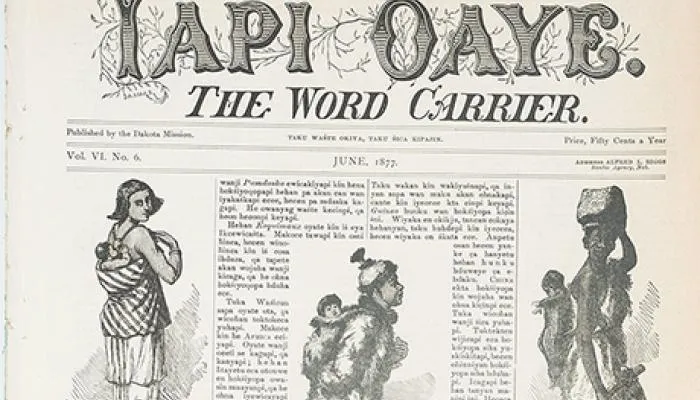

Iapi Oaye - The Word Carrier, Santee Newspaper from 1871 to 1939
Back in 1871, something special started for the Dakota Mission community in the form of a newspaper called Iapi Oaye. Reverend J. P. Williamson set it all up, aiming to create a platform where the Dakota people could read about things that mattered to them in their own language. For a start, the paper rolled off the presses in Chicago, but it wasn't too long before it moved closer to the Dakota, being printed at the Yankton Agency. The paper wasn't just for the locals, though. As it included English content, it picked up a new name, The Word Carrier, and began to reach out to a wider audience. It was a smart move because it started conversations
between the Dakota community and the English-speaking world, showing the value of keeping the Dakota language alive while also opening to new possibilities. Over time, the task of keeping the newspaper going was
passed down through the Riggs family. They were all about making sure the paper stayed relevant and valuable to its readers, changing it up as needed but keeping it true to its roots. Eventually, Iapi Oaye and The Word Carrier split into two separate publications, each with its own focus. The Word Carrier expanded its horizon, taking on stories about mission work and happenings at the Santee Normal Training School, aiming to draw interest and support from the East. Iapi Oaye stuck with local matters, talking about things that directly affected the Dakota people. One of the key figures in this story was Alfred L. Riggs. He ran the Santee Normal Training School and believed strongly in teaching in both English and Dakota. He understood the importance of reaching people in the language that spoke to their hearts. His approach went against the government's push for English-only education, but it was the right move for the Dakota. The newspapers didn't just share news; they captured the shifts and struggles within the Sioux community. Dakota Christians writing for the paper added their perspective, helping to explain the complex cultural shifts their people were experiencing. When 1890 came around, The Word Carrier covered significant events like the Ghost Dance and Wounded Knee in a way that the Dakota could truly understand. Despite its important role, the Santee Normal Training School faced tough times financially, and by 1936, it had to shut down. Three years later, Iapi Oaye followed suit. It was a tough break for the community, marking an end to a critical chapter in Dakota education and storytelling. Today, the story of Iapi Oaye and The Word Carrier hasn't been left to gather dust. These papers stand as a testament to the Dakota’s resilience, their commitment to education, and the power of language. They serve as a reminder of the community's journey, the challenges faced, and the strength found in preserving their language and culture.


